14-1: Leaders
 Think about the best boss you’ve ever had. What made them so effective? Maybe they inspired you to do your best work, helped you grow professionally, or created a team environment where everyone felt valued. Now think about the worst boss you’ve experienced. Chances are, they did the opposite – micromanaged, played favorites, or left you feeling confused about expectations and unsupported in your role.
Think about the best boss you’ve ever had. What made them so effective? Maybe they inspired you to do your best work, helped you grow professionally, or created a team environment where everyone felt valued. Now think about the worst boss you’ve experienced. Chances are, they did the opposite – micromanaged, played favorites, or left you feeling confused about expectations and unsupported in your role.
These experiences highlight why leadership is one of the most important and extensively studied topics in organizational psychology. Good leadership can transform workplaces, inspire incredible performance, and help people reach their potential. Bad leadership can destroy morale, waste talent, and drive good people away from organizations.
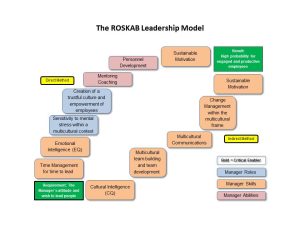
A Leadership Parable
Consider this story adapted from Covey (2004): A group of workers and their leaders are set a task of clearing a road through a dense jungle on a remote island to get to the coast where an estuary provides a perfect site for a port. The leaders organize the labor into efficient units and monitor the distribution and use of capital assets – progress is excellent. The leaders continue to monitor and evaluate progress, making adjustments along the way to ensure progress is maintained and efficiency increased wherever possible.
Then, one day amidst all the hustle and bustle and activity, one person climbs up a nearby tree. The person surveys the scene from the top of the tree and shouts down to the assembled group below: “Wrong Way!”
This story perfectly illustrates the fundamental distinction between management and leadership. As Warren Bennis and Peter Drucker famously noted, “management is doing things right, leadership is doing the right things.” While managers focus on efficiency and making sure systems run smoothly (organizing labor, monitoring progress, making adjustments), leaders focus on vision, inspiration, and ensuring we’re headed in the right direction.
Managers vs. Leaders: Key Distinctions
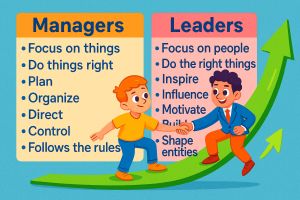
You might be thinking, “I’m not in a leadership position, so why should I care about this?” Here’s the thing – you probably already are a leader in some capacity, even if you don’t realize it. Maybe you’re the person others turn to for advice in your study group, or you’ve taken the initiative on group projects, or you’ve helped train new employees at your part-time job. Leadership happens at all levels, not just in corner offices.
Today’s organizations face challenges that would have seemed impossible to previous generations. Globalization means working with people across cultures and time zones. Technology is disrupting entire industries faster than ever before. Employees have different expectations about work-life balance and meaningful careers. In this complex environment, traditional “command and control” management just doesn’t cut it anymore.
The evolution of leadership theory reflects our growing understanding that there’s no one-size-fits-all approach to leadership. Early researchers thought they could identify universal traits that made someone a great leader. Contemporary theories recognize that leadership effectiveness depends on a complex mix of the leader’s characteristics, what followers need, the situation they’re all in, and the broader organizational context.
What we do know for certain is that effective leadership makes a huge difference. It affects employee satisfaction, commitment, performance, and whether people stick around or leave. The quality of leadership relationships influences not just immediate work results, but also individual well-being, team effectiveness, and overall organizational culture.
Defining Leadership and Leadership Types
So what exactly is leadership? At its core, leadership is a social process through which an individual intentionally exerts influence over others to structure their behaviors and relationships in pursuit of common goals. It’s about motivating others in an organization to work toward shared objectives.
Notice a few key things about this definition: it’s intentional (not accidental), it’s social (involves relationships), and it’s goal-oriented (focused on achieving something meaningful). The influence component is what makes leadership work – unlike coercion or manipulation, leadership influence involves willing compliance from followers who see the leader’s influence as legitimate and beneficial.
Goal orientation is what separates leadership from just being popular or influential. Leaders mobilize collective effort toward shared purposes rather than just pursuing personal interests or random influence attempts. They’re trying to accomplish something meaningful that benefits the group, organization, or society.
Measurement of leadership effectiveness typically focuses on outcomes – did the team perform well? Are people satisfied and engaged? Is the organization innovating and adapting? However, effectiveness can be tricky to evaluate because different stakeholders care about different things, and some results take time to become apparent.
Now let’s examine the various leadership styles you’ll encounter in your career. Understanding these approaches will help you recognize what kind of leadership you’re experiencing and think about what kind of leader you want to become.
Transformational Leadership
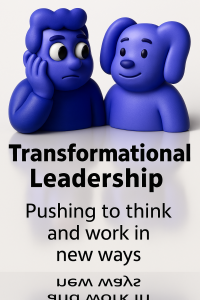 Transformational leaders go beyond managing tasks—they seek to elevate followers by inspiring them to transcend self-interest for the sake of the group or mission. They foster deep commitment, creativity, and personal growth.
Transformational leaders go beyond managing tasks—they seek to elevate followers by inspiring them to transcend self-interest for the sake of the group or mission. They foster deep commitment, creativity, and personal growth.
Core components:
- Idealized Influence – Acting as ethical role models
- Inspirational Motivation – Communicating a compelling vision
- Intellectual Stimulation – Encouraging innovation and critical thinking
- Individualized Consideration – Supporting personal development
Impact:
- Boosts morale, engagement, and performance
- Builds strong leader-follower relationships
- Drives organizational change and innovation
Best used when: Organizations need cultural transformation, innovation, or deep commitment to shared goals.
Autocratic Leadership
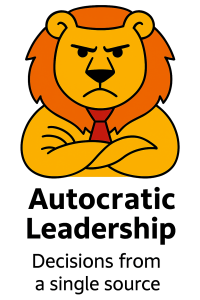 Autocratic leadership involves making decisions without input from followers. Autocratic leaders maintain tight control and expect compliance with their directives. While this might sound inherently problematic, it can actually be appropriate in certain situations – like emergencies where quick decisions are critical, or when followers lack the expertise to contribute meaningfully to decisions.
Autocratic leadership involves making decisions without input from followers. Autocratic leaders maintain tight control and expect compliance with their directives. While this might sound inherently problematic, it can actually be appropriate in certain situations – like emergencies where quick decisions are critical, or when followers lack the expertise to contribute meaningfully to decisions.
Key characteristics:
- Employees’ opinions are not considered
- High degree of dependency on the leader
- Can create demotivation and alienation of staff
- May be valuable where decisions need to be made quickly and decisively
The downside is that autocratic leadership creates high dependency on the leader and can undermine follower development. If people never get to participate in decision-making, they don’t develop those skills themselves. Plus, many people find autocratic leadership demotivating because it doesn’t give them a voice in decisions that affect their work.
Democratic Leadership
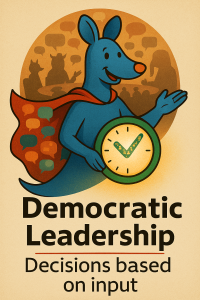 Democratic leadership takes the opposite approach by encouraging decision-making from multiple perspectives and emphasizing participation throughout the organization. This can include:
Democratic leadership takes the opposite approach by encouraging decision-making from multiple perspectives and emphasizing participation throughout the organization. This can include:
- Consultative approaches: Leaders seek input before deciding
- Persuasive approaches: Leaders make decisions then work to convince others they’re good ones
Advantages of democratic leadership include:
- Enhanced motivation through participation
- Increased sense of ownership among followers
- Improved decision quality through better information sharing
- Workers feel ownership of the firm and its ideas
- Improves sharing of ideas and experiences
However, democratic processes can slow down decision-making and create confusion when consensus can’t be reached.
Laissez-Faire Leadership
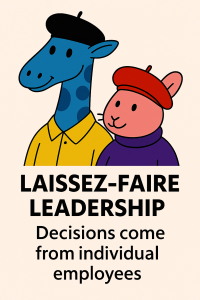 Laissez-faire leadership distributes leadership responsibilities broadly among group members while minimizing formal leader direction. This “hands-off” approach:
Laissez-faire leadership distributes leadership responsibilities broadly among group members while minimizing formal leader direction. This “hands-off” approach:
- Can enhance motivation by providing autonomy
- May stimulate creativity in environments where innovation is critical
- Can be highly motivational as people have control over their working life
- Relies heavily on good teamwork and interpersonal relations
But it requires team members with strong interpersonal skills and self-direction to prevent coordination problems. It can make coordination and decision-making time-consuming and lacking in overall direction.
Additional Leadership Styles
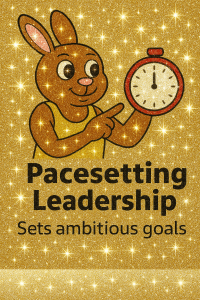 Pacesetting leaders set high standards for performance and expect their team to follow their lead. They often lead by example, demonstrating excellence and expecting others to keep up. This style can drive short-term results, especially with highly skilled teams, but may lead to burnout or reduced morale if used excessively.
Pacesetting leaders set high standards for performance and expect their team to follow their lead. They often lead by example, demonstrating excellence and expecting others to keep up. This style can drive short-term results, especially with highly skilled teams, but may lead to burnout or reduced morale if used excessively.
Key traits: High expectations, fast-paced execution, minimal tolerance for underperformance.
Best used when: Team members are highly competent and motivated, and quick results are needed.
Paternalistic leadership adopts a “father figure” approach where leaders make decisions while consulting followers and providing support for their development and well-being. This style emphasizes care and concern for followers while maintaining leader authority over important decisions.
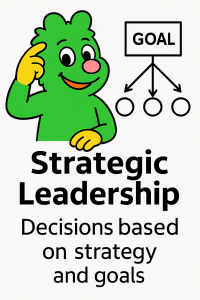 Strategic leadership bridges senior management perspectives with employee needs, balancing competing demands while maintaining organizational direction and employee engagement. Strategic leaders think about the big picture while staying connected to day-to-day realities.
Strategic leadership bridges senior management perspectives with employee needs, balancing competing demands while maintaining organizational direction and employee engagement. Strategic leaders think about the big picture while staying connected to day-to-day realities.
Bureaucratic leadership emphasizes following organizational policies and procedures, with company rules taking precedence over individual preferences or situational considerations. Leaders listen to employees and consider their needs, but company policy always comes first. While this ensures consistency and compliance, it can reduce flexibility and responsiveness.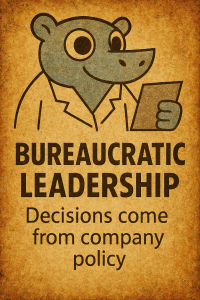
 Coach-style leadership focuses on follower growth and development by encouraging individuals to leverage their strengths and talents. This developmental approach emphasizes learning and improvement rather than just directing task performance.
Coach-style leadership focuses on follower growth and development by encouraging individuals to leverage their strengths and talents. This developmental approach emphasizes learning and improvement rather than just directing task performance.
Visionary leadership focuses on the future, articulating a compelling long-term vision that inspires and aligns their team. They are often charismatic and forward-thinking, helping others see how their work contributes to a larger purpose.
Strengths:
- Inspires commitment and enthusiasm
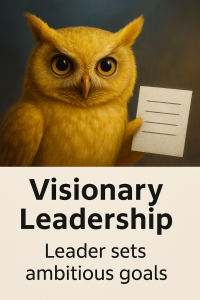
- Provides clear direction during change
- Encourages innovation and strategic thinking
Limitations: - May overlook operational details
- Requires strong communication skills to be effective
Best used when: Organizations face major transitions or need to rally around a new strategic direction.
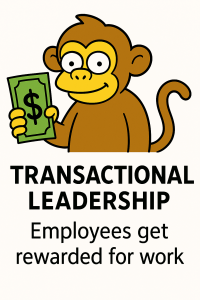 Transactional leaders focus on structured tasks and clear exchanges: performance is rewarded, and failure is corrected. This style emphasizes clarity, efficiency, and accountability.
Transactional leaders focus on structured tasks and clear exchanges: performance is rewarded, and failure is corrected. This style emphasizes clarity, efficiency, and accountability.
Strengths:
- Clarifies expectations and consequences
- Works well in stable environments
- Encourages goal-oriented behavior
Limitations: - May not inspire long-term commitment or innovation
- Relies heavily on external motivation
Best used when: Tasks are routine, roles are clearly defined, and performance metrics are straightforward.
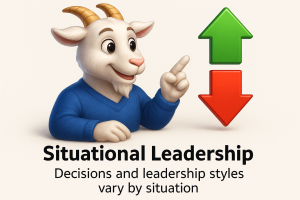 Situational leadership, which is my preferred leadership (and parenting) style, emphasizes adaptability. Leaders assess follower readiness—based on competence and commitment—and adjust their style accordingly. Developed by Hersey and Blanchard, this model includes four styles:
Situational leadership, which is my preferred leadership (and parenting) style, emphasizes adaptability. Leaders assess follower readiness—based on competence and commitment—and adjust their style accordingly. Developed by Hersey and Blanchard, this model includes four styles:
- Directing – High structure, low support (for low readiness)
- Coaching – High structure, high support (for moderate readiness)
- Supporting – Low structure, high support (for higher readiness)
- Delegating – Low structure, low support (for high readiness)
Strengths:
- Highly flexible and responsive
- Encourages leader development and follower autonomy
Limitations: - Requires accurate assessment of follower readiness
- Can be complex to implement consistently
Best used when: Teams vary in experience and motivation, or when tasks and contexts change frequently.
Finally, there’s micromanagement – and this one’s almost always problematic. Micromanagers provide excessive supervision of details while failing to delegate appropriate responsibility. They often: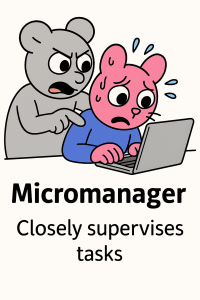
- Maintain impossibly high standards
- Provide insufficient appreciation for good performance
- Create unrealistic deadlines
- Focus more on what needs improving rather than expressing gratitude
- Underestimate timing and set extreme deadlines
Media Attributions
- Leader © Unknown is licensed under a Public Domain license
- ROSKAB Leadership Model © ReingholdKohler is licensed under a CC BY-SA (Attribution ShareAlike) license
- Managers vs. Leaders © Jay Brown and Copilot
- Transformational Leadership © Jay Brown and Copilot
- Autocratic Leadership © Jay Brown and Copilot
- Democratic Leadership © Jay Brown and Copilot
- Laissez-Faire Leadership © Jay Brown and Copilot
- Pacesetting Leadership © Jay Brown and Copilot
- Strategic Leadership © Jay Brown and Copilot
- Bureaucratic Leadership © Jay Brown & Copilot
- Coaching Leadership © Jay Brown and Copilot
- Visionary Leadership © Jay Brown and Copilot
- Transactional Leadership © Jay Brown and Copilot
- Situational Leadership © Jay Brown and Copilot
- Micromanager © Jay Brown and Copilot
